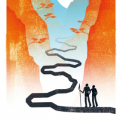The three myths
 Jeroen
Not all those who wander are lostNetherlands Veteran
Jeroen
Not all those who wander are lostNetherlands Veteran
This was written by a Buddhist acquaintance of mine, in Dutch at the Dutch Buddhist Daily here, and I thought it might be nice to bring you all the English translation. See what you think. It’s about types of Buddhist path, which he expresses as three ‘myths’.
And all three are not 'real' at all but mythical: they are attempts to express something in language that cannot be expressed in words in essence . Hence, each of these myths has strong aspects but also pitfalls: ways in which they can be misunderstood in practice, and overshoot. Thus, the practice of a follower or group is no longer the original path intended by the Buddha and Sangha, but slowly descends into a caricature. It is up to all of us to form our own proper path, based on the core values behind these three myths, empowered by a Sangha trying to save us from caricatures…
Myth 1: The Development Path
You see this a lot at theravada but also in most (mahayana) zen schools. We are in the samsara shit full of greed and want to develop into the coveting-free and blissful enlightened state, whether it is called nirvana or being-with-Sunyata. The strong side of this is to make it clear that following the path is always 'hard work': to transcend your ego and to get rid of impurity and desire. You work hard on this with meditation, study, ethical behavior, pujas etc. The pitfall is that you could get the illusion that 'you' do it yourself. And the trick is that reaching enlightenment rises above 'you', 'the ego cannot cancel the ego itself'. So the whole process of hard work is the art of slowly realizing that the doer, that which develops in you, is something much greater than your old self - and perhaps more and more one with everything around you!Myth 2: The Surrender Way
Enlightenment here is not so much about taking the lead yourself, but to be inspired by bodhisattvas and Buddhas.
They "help you to be enlightened" by letting yourself be inspired by their example, which of course itself is derived from the historical Buddha. Pure Land is the most explicit school in this route, but you will of course also find that inspiration in parts of Tibetan / Vajrayana schools. And like many later schools, he is indeed inspired by or goes back to the time of the Buddha himself. You see him in the Pali Canon especially with direct followers of the Buddha such as Mogallana and Ananda, who worship him as later Mahayanists worship the Bodhisattvas and Buddhas.The strong point is to make clear to you again and again that there is a supernatural power of enlightenment, and the trick is to (sometimes) take out your own ego will and instead do what that power inspires you. The pitfall is, however, that people sometimes become 'lazy' from the surrender path. They hardly do anything about meditation, study and ethical behavior and are really only present at the pujas / chanting services without really opening themselves up to them. While nothing demands as much effort as getting sharp how to follow the example of Amitabha, Buddha, Padmasambhava etc. at any given time. Sharpness in polishing your intuition and openness (no I had better avoid the word 'developing' here) and in opening up to that Inspiration of enlightened energy. And in this too, study, meditation / reflection and ethical behavior are essential!
Myth 3: The Buddha Nature Way
In other words, the 'Tathagatagarbha': 'I am already enlightened at the core, but still have to live up to it'.
The art here is not so much developing-by-learning-new-properties or absorbing-lighting-by-inspiration-from the outside, but realizing lighting by seeing that the essence was already within you. You see it in various mahayana and vajrayana schools. Inspiration goes back to the Pali Canon: just think of the scene that emaciated Gautama decides to eat again because he thought back to a meditative experience as a child. An experience that taught him that he had always known the ideal Nirvana experience. The strong point is to make it clear to you that enlightenment is not something weird far away but something very close to your True Nature; if not that stupid ego but always block that True Nature! And the pitfall is twofold. First, laziness again, you can fool yourself with cries like 'I'm almost there anyway'. Second, you run the risk of confusing bits of hidden ego with your Buddha nature / True Nature. It is almost boring, but study, meditation / reflection, ethical behavior and pujas / devotion can also play an important role in this way!





Comments
Pretty accurate and in accord with what I have observed of the Buddhist world.
Their main benefit is the reminder of the inherent potential failings or blind spots that are typical of the category that each of us finds ourselves standing within and if one is in a teaching position, how to consider helping those standing in categories that are different from our own.
As a mythical self delusion, I value the broken.
The free chain so to speak. The putting on of shackles and restraints. It is why I wear a mask.
To put it another way:
“Dance, when you're broken open. Dance, if you've torn the bandage off. Dance in the middle of the fighting. Dance in your blood. Dance when you're perfectly free.”
― Rumi
Wot no legs? Heart Dance!
... and now back to myth breaking ...
I really like the explanation of these different categories, as @how put it. It’s definitely worth being aware of the pitfalls in your path. But it’s quite bold to claim that they’re all myths and “not real at all”, don’t you think? They’re pretty real to a lot of people across the world.
Perhaps myth isn’t the right word, they are more like styles of the different traditions. But it extends beyond just Buddhist traditions, many other traditions also use these styles.
I’ve come across a fourth style, which may be a variation of the first, that one should strive for continual progress and becoming a better person. This was stated to me by a man who is a Buddhist teacher here in the Netherlands...
I think I like that. To me its sort of like the first but instead of trying to be perfect and reach some end state, we're rather trying to continually and perhaps endlessly just trying to be better. And for myself understanding that its okay to misstep or go astray, its all manure for the mango trees.